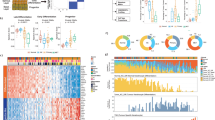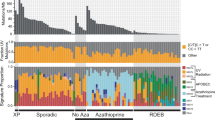Abstract
Multiple self-healing squamous epithelioma (MSSE), also known as Ferguson-Smith disease (FSD), is an autosomal-dominant skin cancer condition characterized by multiple squamous-carcinoma–like locally invasive skin tumors that grow rapidly for a few weeks before spontaneously regressing, leaving scars1,2. High-throughput genomic sequencing of a conservative estimate (24.2 Mb) of the disease locus on chromosome 9 using exon array capture identified independent mutations in TGFBR1 in three unrelated families. Subsequent dideoxy sequencing of TGFBR1 identified 11 distinct monoallelic mutations in 18 affected families, firmly establishing TGFBR1 as the causative gene. The nature of the sequence variants, which include mutations in the extracellular ligand-binding domain and a series of truncating mutations in the kinase domain, indicates a clear genotype-phenotype correlation between loss-of-function TGFBR1 mutations and MSSE. This distinguishes MSSE from the Marfan syndrome–related disorders in which missense mutations in TGFBR1 lead to developmental defects with vascular involvement but no reported predisposition to cancer.
This is a preview of subscription content, access via your institution
Access options
Subscribe to this journal
Receive 12 print issues and online access
$209.00 per year
only $17.42 per issue
Buy this article
- Purchase on Springer Link
- Instant access to full article PDF
Prices may be subject to local taxes which are calculated during checkout





Similar content being viewed by others
Accession codes
Accessions
GenBank/EMBL/DDBJ
NCBI Reference Sequence
References
Ferguson-Smith, J. A case of multiple primary squamous-celled carcinomata in a young man, with spontaneous healing. Br. J. Dermatol. 46, 267–272 (1934).
Ferguson-Smith, M.A., Wallace, D.C., James, Z.H. & Renwick, J.H. Multiple self-healing squamous epithelioma. Birth Defects Orig. Artic. Ser. 7, 157–163 (1971).
Bose, S. et al. The elusive multiple self-healing squamous epithelioma (MSSE) gene: further mapping, analysis of candidates, and loss of heterozygosity. Oncogene 25, 806–812 (2006).
Goudie, D.R. et al. Multiple self-healing squamous epitheliomata (ESS1) mapped to chromosome 9q22-q31 in families with common ancestry. Nat. Genet. 3, 165–169 (1993).
Richards, F.M. et al. Mapping the multiple self-healing squamous epithelioma (MSSE) gene and investigation of xeroderma pigmentosum group A (XPA) and PATCHED (PTCH) as candidate genes. Hum. Genet. 101, 317–322 (1997).
D'Alessandro, M. et al. Multiple self-healing squamous epithelioma in different ethnic groups: more than a founder mutation disorder? J. Invest. Dermatol. 127, 2336–2344 (2007).
Broesby-Olsen, S., Bygum, A., Gerdes, A.M. & Brandrup, F. Multiple self-healing squamous epithelioma of Ferguson-Smith: observations in a Danish family covering four generations. Acta Derm. Venereol. 88, 52–56 (2008).
Ervais-Wakosa, A. Kérato-acanthomes multiples héréditaires: syndrome de Ferguson-Smith en Bourgogne. Médecine Sciences 10 (2010).
Robertson, S.J., Bashir, S.J., Pichert, G., Robson, A. & Whittaker, S. Severe exacerbation of multiple self-healing squamous epithelioma (Ferguson-Smith disease) with radiotherapy, which was successfully treated with acitretin. Clin. Exp. Dermatol. 35, e100–e102 (2010).
Wright, A.L., Gawkrodger, D.J., Branford, W.A., McLaren, K. & Hunter, J.A. Self-healing epitheliomata of Ferguson-Smith: cytogenetic and histological studies, and the therapeutic effect of etretinate. Dermatologica 176, 22–28 (1988).
Feldman, R.J. & Maize, J.C. Multiple keratoacanthomas in a young woman: report of a case emphasizing medical management and a review of the spectrum of multiple keratoacanthomas. Int. J. Dermatol. 46, 77–79 (2007).
Koga, Y. et al. A case of Ferguson-Smith type keratoacanthoma extending over three generations. Jap. J. Plastic Reconstuct. Surg. 46, 185–192 (2003).
Kato, N., Ito, K., Kimura, K. & Shibata, M. Ferguson-Smith type multiple keratoacanthomas and a keratoacanthoma centrifugum marginatum in a woman from Japan. J. Am. Acad. Dermatol. 49, 741–746 (2003).
Miyazono, K. Transforming growth factor-beta signaling in epithelial-mesenchymal transition and progression of cancer. Proc. Jpn. Acad., Ser. B, Phys. Biol. Sci. 85, 314–323 (2009).
Glick, A.B. TGFβ1, back to the future: revisiting its role as a transforming growth factor. Cancer Biol. Ther. 3, 276–283 (2004).
Kaklamani, V.G. et al. TGFBR1*6A and cancer risk: a meta-analysis of seven case-control studies. J. Clin. Oncol. 21, 3236–3243 (2003).
Kaklamani, V.G. & Pasche, B. Role of TGF-β in cancer and the potential for therapy and prevention. Expert Rev. Anticancer Ther. 4, 649–661 (2004).
Cui, W. et al. TGFβ1 inhibits the formation of benign skin tumors, but enhances progression to invasive spindle carcinomas in transgenic mice. Cell 86, 531–542 (1996).
Shipley, G.D., Pittelkow, M.R., Wille, J.J. Jr., Scott, R.E. & Moses, H.L. Reversible inhibition of normal human prokeratinocyte proliferation by type beta transforming growth factor-growth inhibitor in serum-free medium. Cancer Res. 46, 2068–2071 (1986).
Guasch, G. et al. Loss of TGFβ signaling destabilizes homeostasis and promotes squamous cell carcinomas in stratified epithelia. Cancer Cell 12, 313–327 (2007).
Bian, Y. et al. Progressive tumor formation in mice with conditional deletion of TGF-β signaling in head and neck epithelia is associated with activation of the PI3K/Akt pathway. Cancer Res. 69, 5918–5926 (2009).
Loeys, B.L. et al. A syndrome of altered cardiovascular, craniofacial, neurocognitive and skeletal development caused by mutations in TGFBR1 or TGFBR2. Nat. Genet. 37, 275–281 (2005).
Mizuguchi, T. & Matsumoto, N. Recent progress in genetics of Marfan syndrome and Marfan-associated disorders. J. Hum. Genet. 52, 1–12 (2007).
Stheneur, C. et al. Identification of 23 TGFBR2 and 6 TGFBR1 gene mutations and genotype-phenotype investigations in 457 patients with Marfan syndrome type I and II, Loeys-Dietz syndrome and related disorders. Hum. Mutat. 29, E284–E295 (2008).
Breckpot, J., Budts, W., De Zegher, F., Vermeesch, J.R. & Devriendt, K. Duplication of the TGFBR1 gene causes features of Loeys-Dietz syndrome. Eur. J. Med. Genet. 53, 408–410 (2010).
Loeys, B.L. et al. Aneurysm syndromes caused by mutations in the TGF-β receptor. N. Engl. J. Med. 355, 788–798 (2006).
Knudson, A.G. Jr. Mutation and cancer: statistical study of retinoblastoma. Proc. Natl. Acad. Sci. USA 68, 820–823 (1971).
Bandyopadhyay, B. et al. A 'traffic control' role for TGFβ3: orchestrating dermal and epidermal cell motility during wound healing. J. Cell Biol. 172, 1093–1105 (2006).
Adès, L.C. et al. FBN1, TGFBR1 and the Marfan-craniosynostosis/mental retardation disorders revisited. Am. J. Med. Genet. A. 140, 1047–1058 (2006).
Akutsu, K. et al. Phenotypic heterogeneity of Marfan-like connective tissue disorders associated with mutations in the transforming growth factor-beta receptor genes. Circ. J. 71, 1305–1309 (2007).
Drera, B. et al. Loeys-Dietz syndrome type I and type II: clinical findings and novel mutations in two Italian patients. Orphanet J. Rare Dis. 4, 24 (2009).
Drera, B., Tadini, G., Barlati, S. & Colombi, M. Identification of a novel TGFBR1 mutation in a Loeys-Dietz syndrome type II patient with vascular Ehlers-Danlos syndrome phenotype. Clin. Genet. 73, 290–293 (2008).
Mátyás, G. et al. Identification and in silico analyses of novel TGFBR1 and TGFBR2 mutations in Marfan syndrome-related disorders. Hum. Mutat. 27, 760–769 (2006).
Sakai, H. et al. Comprehensive genetic analysis of relevant four genes in 49 patients with Marfan syndrome or Marfan-related phenotypes. Am. J. Med. Genet. A. 140, 1719–1725 (2006).
Singh, K.K. et al. TGFBR1 and TGFBR2 mutations in patients with features of Marfan syndrome and Loeys-Dietz syndrome. Hum. Mutat. 27, 770–777 (2006).
Söylen, B. et al. Prevalence of dural ectasia in 63 gene-mutation-positive patients with features of Marfan syndrome type 1 and Loeys-Dietz syndrome and report of 22 novel FBN1 mutations. Clin. Genet. 75, 265–270 (2009).
Tran-Fadulu, V. et al. Analysis of multigenerational families with thoracic aortic aneurysms and dissections due to TGFBR1 or TGFBR2 mutations. J. Med. Genet. 46, 607–613 (2009).
Lee, H. et al. Improving the efficiency of genomic loci capture using oligonucleotide arrays for high throughput resequencing. BMC Genomics 10, 646 (2009).
Homer, N., Merriman, B. & Nelson, S.F. BFAST: an alignment tool for large scale genome resequencing. PLoS ONE 4, e7767 (2009).
Clark, M.J. et al. U87MG decoded: the genomic sequence of a cytogenetically aberrant human cancer cell line. PLoS Genet. 6, e1000832 (2010).
Li, H. et al. The Sequence Alignment/Map format and SAMtools. Bioinformatics 25, 2078–2079 (2009).
O'Connor, B.D., Merriman, B. & Nelson, S.F. SeqWare Query Engine: storing and searching sequence data in the cloud. BMC Bioinformatics 11, Suppl 12, S2 (2010).
Cottingham, R.W. Jr., Idury, R.M. & Schaffer, A.A. Faster sequential genetic linkage computations. Am. J. Hum. Genet. 53, 252–263 (1993).
Schäffer, A.A., Gupta, S.K., Shriram, K. & Cottingham, R.W. Jr. Avoiding recomputation in linkage analysis. Hum. Hered. 44, 225–237 (1994).
Radaev, S. et al. Ternary complex of transforming growth factor-β1 reveals isoform-specific ligand recognition and receptor recruitment in the superfamily. J. Biol. Chem. 285, 14806–14814 (2010).
Acknowledgements
This work was supported by Cancer Research UK (grants C26/A4049 to E.B.L. and D.R.G.; C26/A1461, C26/A6694 and C26/A11657 to E.B.L.) and the Biomedical Research Council (A*STAR) of Singapore. We thank the University of California Los Angeles Genomic Sequencing Center for providing access to next-generation sequencing, alignment and variant calling computational systems; F. Richards for tumor DNA; R. Barlow for subject referral; A. Cassidy for help with sequencing and the TaqMan assay; D. Baty for access to the resources of his laboratory and many individuals with MSSE for their help.
Author information
Authors and Affiliations
Contributions
D.R.G. and E.B.L. initiated the project. D.R.G., M.A.F.-S., G.P., A.-M.G., S.B.-O., J.F., I.H., N.B. and S.W. identified, ascertained and took samples from subjects' families. E.B.L., M.D., D.R.G. and B.R. designed strategies, supervised and implemented the project. B.M., H.L., B.D.O. and S.F.N. designed and performed re-analysis of linkage data, array capture reagents, high-throughput sequencing and data analysis and interpretation. M.D. and S.E.C. performed the dideoxy sequencing. D.R.G., L.C. and A.S. performed the loss of heterozygosity (LOH) studies. D.R.G. performed the linkage and haplotype analysis of the discovered variants. I.S., B.R. and S.A. performed the functional assays. D.P.L. performed the immunohistochemistry. C.V. carried out the structural modeling. E.B.L., D.R.G., M.D. and I.S. wrote the paper with contributions from the other authors.
Corresponding author
Ethics declarations
Competing interests
The authors declare no competing financial interests.
Supplementary information
Supplementary Text and Figures
Supplementary Tables 1–3 and Supplementary Figures 1–4. (PDF 1601 kb)
Rights and permissions
About this article
Cite this article
Goudie, D., D'Alessandro, M., Merriman, B. et al. Multiple self-healing squamous epithelioma is caused by a disease-specific spectrum of mutations in TGFBR1. Nat Genet 43, 365–369 (2011). https://doi.org/10.1038/ng.780
Received:
Accepted:
Published:
Issue Date:
DOI: https://doi.org/10.1038/ng.780
This article is cited by
-
Truncating variants in the penultimate exon of TGFBR1 escaping nonsense-mediated mRNA decay cause Loeys-Dietz syndrome
European Journal of Human Genetics (2023)
-
Advances in cutaneous squamous cell carcinoma
Nature Reviews Cancer (2023)
-
Genetic profiling and cardiovascular phenotypic spectrum in a Chinese cohort of Loeys-Dietz syndrome patients
Orphanet Journal of Rare Diseases (2020)
-
Hereditäre Hauttumorsyndrome
Der Hautarzt (2019)
-
Distinct variants affecting differential splicing of TGFBR1 exon 5 cause either Loeys–Dietz syndrome or multiple self-healing squamous epithelioma
European Journal of Human Genetics (2018)



